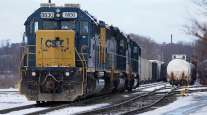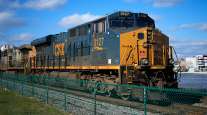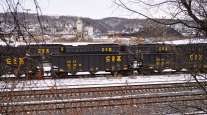Railroad Profit Rebound Plays Catch-Up to Yearlong Stock Surge

With U.S. railroads forecast to report their first earnings growth since 2015, a stock rally that began in anticipation of the profit rebound is looking overdone.
An index of major carriers has jumped more than 55% since sinking to a three-year low Jan. 25, more than doubling the S&P 500 Index’s return. The surge pushed railroad stock prices to more than 21 times earnings, the highest since 2014 for Union Pacific Corp. and the most in at least six years for CSX Corp. and Norfolk Southern Corp., according to data compiled by Bloomberg News.
That’s left limited room for additional short-term gains, said John Larkin, an analyst with Stifel Financial Corp. CSX, last year’s top performer, is likely to fall during the next 12 months, based on the average of 25 analyst estimates. Union Pacific is poised to rise less than 5%, while Norfolk Southern probably will be little changed.
“My sense is the valuations are about as full as they can get,” Larkin said. “For them to go to a higher level, you have to have almost the best of all worlds.”
CSX, which reports fourth-quarter results Jan. 17, probably will post earnings of 50 cents a share, 2 cents more than a year earlier, according to the average of analyst estimates. That would mark the first profit increase since the third quarter of 2015.
Union Pacific probably will report that per-share earnings rose to $1.33 on Jan. 19, based on analyst estimates compiled by Bloomberg. Norfolk Southern’s profit is projected at $1.36 a share, higher than a year earlier.
Investors have pushed up share prices on promises by President-elect Donald Trump to reduce corporate taxes and increase spending on infrastructure, which would spur rail traffic. Railroad bulls also may be counting on tighter truck capacity, which could steer more business to the rails. Those factors, if they happen, wouldn’t spur profits until later this year or in 2018, Larkin said.
Cargo already is starting to rebound, however, with a 1.3% increase for U.S. railroads in the final three months of last year, according to the Association of American Railroads.
That snapped declines in the previous six quarters. Consumer goods, metals and grain led the increases, and freight was helped by a smaller decline in coal.
The fourth-quarter gains kept the annual drop for U.S. rail carloads to 5%. Freight is expected to climb 3.4% this year, according to FTR Transportation Intelligence, a consulting and forecasting firm.
Earnings will recover quickly if railroads can hold expenses in check as they ramp up to handle more cargo, said Lee Klaskow, an analyst with Bloomberg Intelligence. The companies cut costs last year to cope with cargo declines, furloughing workers, parking locomotives and crimping investment. They also extended train lengths to increase efficiency.
Carloads of coal, the largest commodity that railroads haul and among the most profitable, probably will rise 8% this year, according to FTR. Shipments dropped 20% in 2016, hurt by weaker coal demand as utilities switched to natural gas, which costs less and generates less pollution.
“Coal seems to have reached somewhat of a bottom,” Klaskow said. “It’s just going to be a better year for railroads in terms of volume and earnings growth.”
Canadian railroads also saw freight gains in the fourth quarter after annual drops in 2015 and 2016. Unlike their U.S.counterparts, Canadian Pacific Railway Ltd. and Canadian National Railway Co. were able to post several quarterly profit gains last year. Analysts estimate Canadian Pacific’s fourth-quarter earnings will increase to C$3.12 a share, while Canadian National’s will climb to C$1.20.
Their shares also have surged in the past year through Jan. 13, with Canadian Pacific gaining 30% and Canadian National up 28%. That leaves little room for more increases, said David Tyerman, a Cormark Securities analyst in Toronto.
“In my opinion, they’re not compelling to buy at current prices,” he said.




